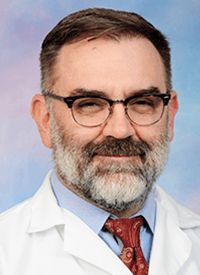Article
REGN5458 Shows Promising ORR and Safety in Relapsed/Refractory Myeloma
Author(s):
Jeffrey Zonder, MD, discusses his presentation at the 2021 ASH Annual Meeting on the impact of the phase 1/2 study utilizing REGN5458 in multiple myeloma.
Jeffrey Zonder, MD

Regeneron 5458 (REGN5458) a bispecific monoclonal antibody, demonstrated favorable overall response rates (ORR) in patients with relapsed or refractory multiple myeloma in a phase 1/2 trial (NCT03761108), according to Jeffrey Zonder, MD.
“[REGN5458] looks extremely promising. It was quite tolerable with very good response rates,” Zonder said. “This supports further development of this bispecific antibody as monotherapy for patients who have progressed after 3 or more lines of therapy, and there's already the phase 2 portion of the study ongoing, accruing patients.”
In an interview with OncLive®, Zonder, professor of oncology, Barbara Ann Karmanos Cancer Institute, Wayne State University, discussed his presentation at the 2021 ASH Annual Meeting on the impact of the phase 1/2 study utilizing REGN5458 in multiple myeloma.
OncLive®: What was the rationale behind this study?
Zonder: This is a first-in-human, phase 1/2 study using a bispecific antibody, which is an antibody that binds 2 different things at the same time. This bispecific, which is called REGN5458, binds BCMA, which is a target molecule on the surface of multiple myeloma cells, and CD3, which is on immune effector cells. By binding both at the same time, it brings the immune system to bear against the multiple myeloma and induces cytotoxicity and cell death.
This was the first part of a 2-part study. This part is the dose escalation part where we were studying different dose levels of the medication to assess safety and to look for dose limiting toxicity to ultimately identify the dose that we want to go forward with for the phase 2 expansion, which is the second part of the study.
This was a phase 1 study using modified 4+3 design doses. The REGN5458 was administered intravenously weekly for the first 16 weeks. After that, it went to every 2 weeks. In the first 2 weeks, we used reduced doses, which was a step-up dosing strategy, to try to minimize certain toxicities. Then the full nominal dose that [patients] were assigned for their dose-level cohort, that started on week 3, and that was given weekly through week 16.
Can you detail data on adverse events observed during the trial?
There were 2 parts to the results. The first was the safety data, and the drug was very well tolerated. We saw very manageable hematologic and non-hematologic toxicity. The most common hematologic [adverse] effects were anemia and neutropenia. Anemia occurred in 32% of patients; neutropenia occurred in 23% of patients.
For non-hematologic toxicities, they were all generally mild, very manageable. The most common was fatigue. The next most common was cytokine release syndrome, which is an infusion reaction that generally occurs early on with bispecific antibodies. It’s seen with basically all bispecific antibodies and also with CAR T cells. The incidence of that was actually low compared with what’s seen with some other molecules that have been reported on at ASH.
The overall incidence of cytokine release was 38%. Almost all the cases were grade 1. There were 3 cases that were grade 2, and there were no grade 3 or worse. Importantly, in addition to the incidents only being 38%, there was no association with dose level. Cytokine release almost always happened within that first 2-week step-up dosing period, usually within 1 day of administration of the antibody. It was a very predictable pattern of occurrence, which reduces the chances that there’ll be some sort of surprise reaction if you were administering in patients in practice.
Can you speak to the efficacy of REGN5458 based on the study?
There was impressive efficacy. We saw early, deep, and durable responses with this bispecific antibody. The ORR for the whole study was 51%, which is impressive because in a dose-finding study, where you’re starting at very low doses, you don’t necessarily expect to see a high response rate. Fifty-one percent compares favorably to the products that are approved in the same space in multiple myeloma.
In the higher dose levels tested, the 200 to 800 mg dose levels, the ORR was 75%. The majority of those responses were deep, with over half of patients achieving a very good partial response or better. That was also true when you looked at responses across all dose levels. The rate of very good partial response remained high, regardless of whether the response happened with low dose or at a higher dose.
[Among all patients], 43% of the responses that we saw were complete responses. There were a handful of patients that we did minimal residual disease [MRD] testing on, which is ultra-sensitive testing looking for extremely low levels of remaining disease. We had that data on 10 patients, and 4 patients achieved MRD negativity.
Are there any next steps or future studies you are anticipating?
In the relatively near future, there's going to be an umbrella-type study, where this drug is going to be studied in combination with various standard myeloma therapies to see how best to utilize this drug in combinations.
What message do you hope colleagues took away from the presentation?
This is a very promising drug. It represents something important, potentially, for patients going forward. A drug with a profile like REGN5458 would be an improvement over most of the approved drugs in this space.
The toxicity profile is excellent, and importantly, the other promising therapy that we’re hearing a lot about at ASH, which is CAR T cells. There are accessibility issues with CAR T cells right now. The commercial CAR T [cells] are difficult to get. There aren't enough slots on CAR T studies for the patients who want to get onto those studies. And a bispecific antibody is an immediately accessible treatment that has seen extremely impressive efficacy so far.






%20(2)%201-Recovered-Recovered-Recovered-Recovered-Recovered.jpg?fit=crop&auto=format)

%20(2)%201-Recovered-Recovered-Recovered-Recovered-Recovered.jpg?fit=crop&auto=format)
%20(2)%201-Recovered-Recovered-Recovered-Recovered-Recovered.jpg?fit=crop&auto=format)